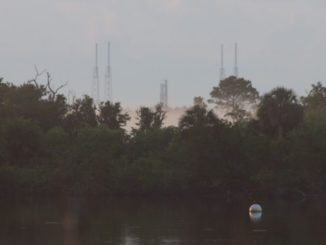
A SpaceX-owned commercial cargo craft splashed down in the Pacific Ocean west of Baja California late Sunday, closing out a 39-day mission that delivered 2.8 tons of supplies, experiments and holiday treats to the International Space Station, and returned home with research specimens and no-longer-needed hardware.
The unpiloted supply ship, loaded with about 2 tons of gear and experiment specimens, departed the space station at 6:33 p.m. EST (2333 GMT) Sunday with a ground-commanded release from the orbiting research lab’s 58-foot (17.7-meter) Canadian-built robotic arm. The Dragon capsule fired its thrusters for a series of departure burns to fly away from the station’s vicinity, setting up for a deorbit burn at 11:19 p.m. EST (0419 GMT) to slow the craft’s velocity enough to drop out of orbit and re-enter Earth’s atmosphere.
Soon after completing the braking burn, the Dragon spacecraft jettisoned its disposable trunk section, which is designed to burn up in the atmosphere. The pressurized section of Dragon, meanwhile, plunged back to Earth protected by a heat shield, then deployed a series of parachutes to slow down for splashdown in the Pacific Ocean southeast of Guadalupe Island, off the west coast of Baja California.
SpaceX confirmed a successful splashdown in a tweet at 9:12 p.m. PST Sunday (12:12 a.m. EST; 0512 GMT Monday), wrapping up the company’s 16th Dragon resupply mission to the International Space Station since 2012.
NASA’s contract with SpaceX is valued at $3.04 billion for 20 cargo missions to the space station from 2012 through next year. Another NASA contract guarantees SpaceX at least six additional resupply missions to the station through 2024, for an unspecified amount.
The Dragon cargo capsule launched Dec. 5 from Cape Canaveral Air Force Station in Florida aboard a SpaceX Falcon 9 rocket, and the spaceship completed an automated rendezvous with the space station Dec. 8 to deliver 5,673 pounds (2,573 kilograms) of provisions and experiments.
The cargo delivery included 40 mice sent to the space station to study the effects of microgravity on the animals’ immune systems, muscles and bones, information that scientists compare to the condition of a control group of mice kept on Earth. Twenty of the mice were expected to travel back to Earth aboard the Dragon capsule Sunday.
Also delivered to the space station aboard Dragon was a scientific investigation to grow protein crystals in microgravity, with the aim to help researchers understand how an antioxidant protein helps protect the human body from oxidizing radiation. Scientists also sent up experiments to study the causes of muscle abnormalities observed in spaceflight, and to examine the corrosion of carbon steel materials in space.
In addition to the biological experiments stowed inside the Dragon’s internal compartment, the spaceship’s rear cargo bay contained a pair of NASA payloads that were mounted outside the space station by the robotic arm. One will demonstrate new tools and techniques that could lead to a future capability to refuel satellites with cryogenic propellants in space, and another will scan the planet with a laser to measure the height, density and structure of forest canopies, data that could tell scientists more about the role of forests in the carbon cycle.
Once astronauts finished unpacking the fresh supplies, they installed refrigerated samples and other equipment into Dragon spacecraft for return to Earth.
Dragon’s return was scheduled for Thursday, but officials pushed back the departure due to bad weather in the splashdown zone in the Pacific Ocean. Managers eventually decided to target Dragon’s return to a different location farther south in the Pacific to take advantage of calmer seas, shifting the cargo freighter’s departure and splashdown from Sunday morning to Sunday night.
It was the second nighttime splashdown of a Dragon spacecraft, following a return before dawn in July 2017. But much of the work to retrieve the capsule on that mission occurred in daytime, which a nighttime recovery was planned overnight Sunday into Monday.
SpaceX’s Dragon recovery team will hoist the capsule on a boat for the trip back to the Port of Los Angeles, where crews will remove time-sensitive samples from Dragon for return to science labs around the country for analysis.
The Dragon capsule that returned to Earth on Sunday night completed its second trip to space after a successful flight to the station in February 2017. SpaceX refurbished the spacecraft for another launch, a practice the company has now followed for five of its resupply missions to the space station.
Email the author.
Follow Stephen Clark on Twitter: @StephenClark1.



